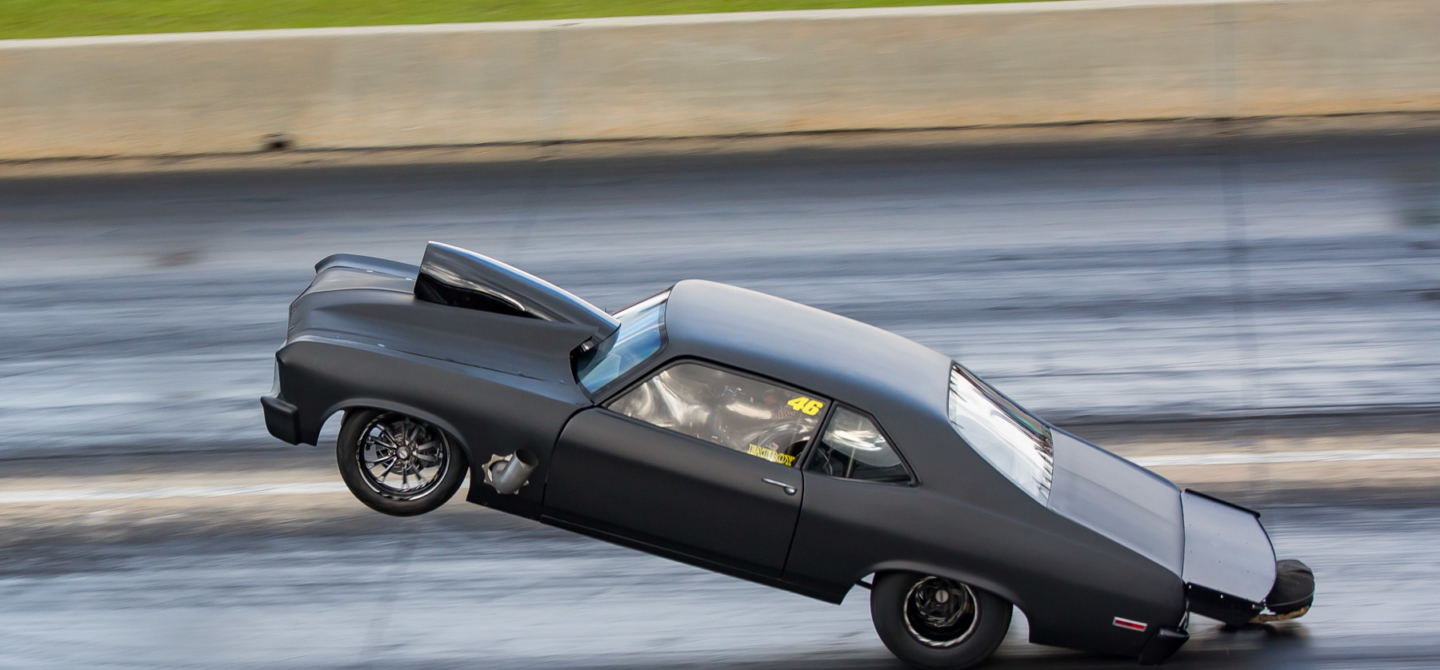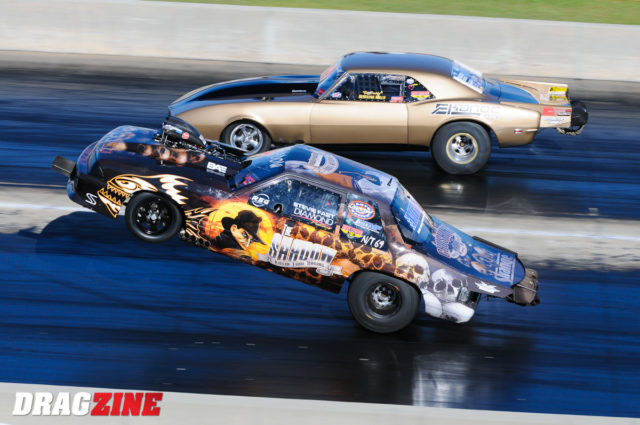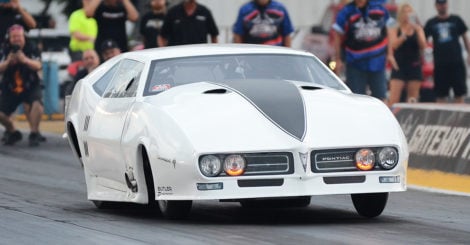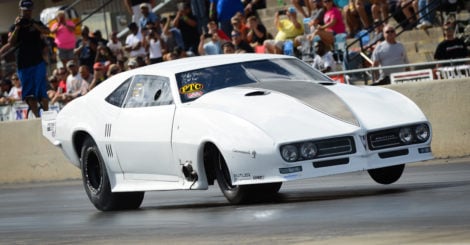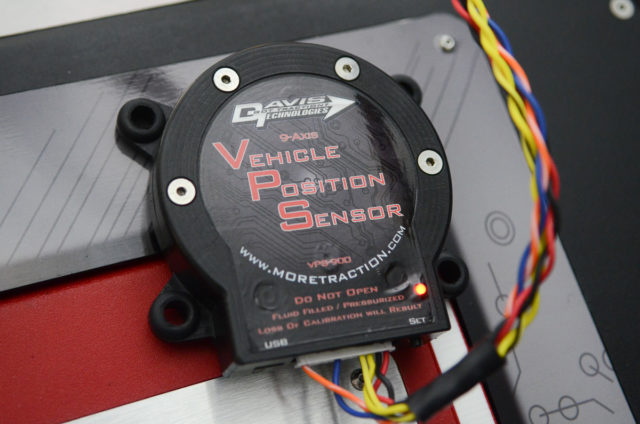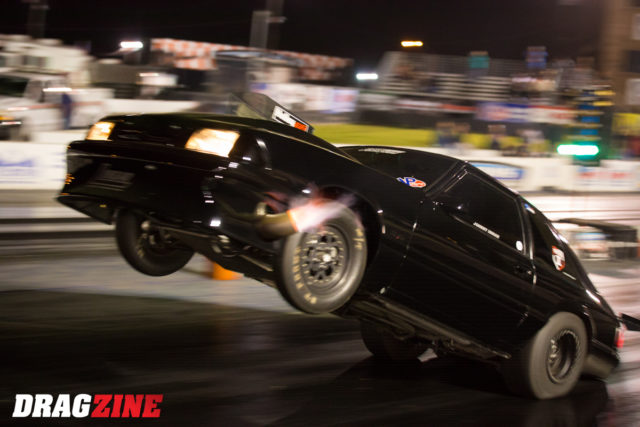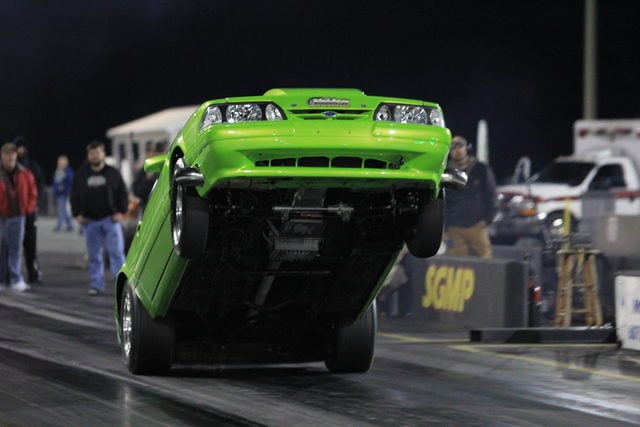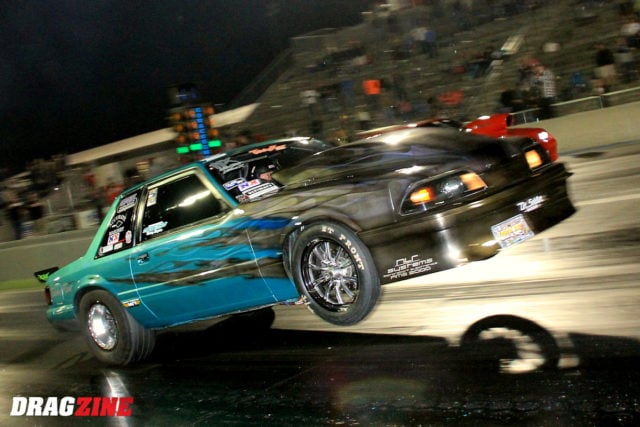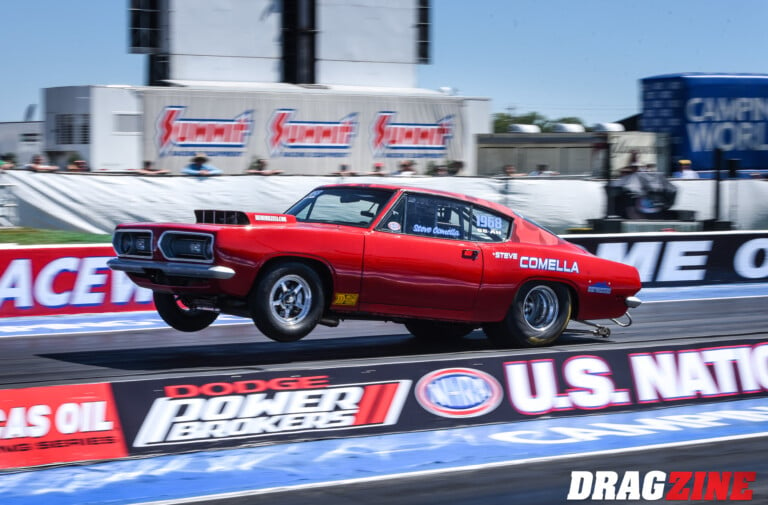Drag radial racing has, over the last decade and change, transformed the drag racing landscape, elevating itself from a niche segment of the sport right into the mainstream. While there are many attributes to thank for it — the cars, the personalities and rivalries, and the stunning performances — the genre has largely built itself upon its unpredictability, and in particular, in its high-flying, wheelstanding nature, which is simply an inherent result of the fundamentals of racing on radials.
These low-earth orbit excursions, occasionally with destructive endings, have frequently led to calls for the widespread use of wheelie bars in the name of safety, while the more technically and electronically inclined have gone to their drawing boards to develop high-tech solutions to prevent it. Nevertheless, the radial tire community remains majority opposed to any mechanical means of keeping the front wheels firmly on the ground. Primarily because, well…radial cars just don’t have “sissy sticks,” and that’s that.
We’re not going to answer whether they should or shouldn’t be mandatory; instead, we’re going to delve into the science of tuning and power management of an all-out radial tire combination, and explain the “how” and “why” of those awe-inspiring wheelstands radial fans have come to know, love, and expect.
The quick and dirty explanation, from a technical standpoint for why wheelstands occur in radial racing is: because they didn’t go quick enough to sixty-feet.
I know. “Wait, hang on, can you repeat that?”
There’s obviously more to that statement — just stick with me here.
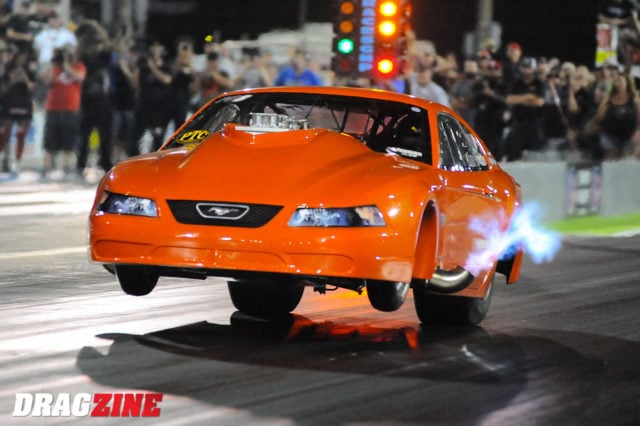
As we’ll hit on later in the text, nitrous oxide-assisted entries are most prone to wheelstands, because of the inherent nature of the combination. Down on horsepower to their boosted counterparts, nitrous cars make up their elapsed time early in a run, meaning they’re applying all of the power they have on tap, while also making the 1-2 gear change and locking up the converter, all within the span of about 1.5-2 seconds.
To those who come from a bias-ply, slick tire background, the fundamentals of a radial car, from the suspension to power management are, as respected and accomplished tuner Jamie Miller put it, “completely opposite” of the traditional approach.
Slick tires, with their bias-ply construction and soft sidewalls, squat upon the launch and live and die on wheel speed. They don’t want too little or too much — one results in tire shake, the other in tire smoke. Instead, they want a highly controlled degree of wheel speed that is gradually brought back in unison with the forward acceleration of the car. The front suspension as well as the four-link, the rear shocks, and the wheelie bar are all finely tuned to control the transfer of weight to accomplish this.
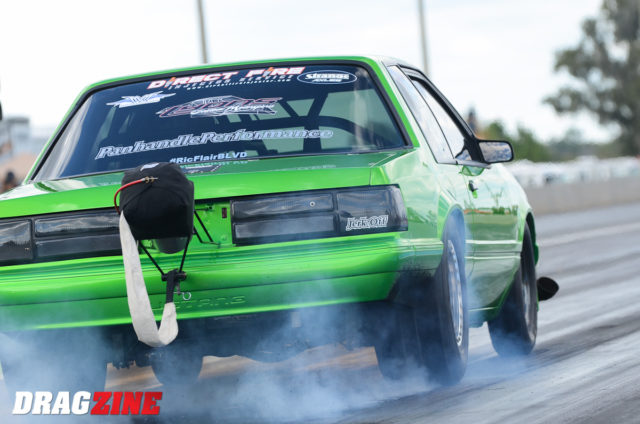
If there’s one thing radial tires don’t like, it’s wheel-speed. Too much power and they’ll enter into unrecoverable spin. Much of this comes down to power management in the first few feet and weight placement within the car.
Back to the radial cars.
If you watch closely at a radial car in the first few feet of a run — or better yet, look at a still photograph — one thing should stand out: the stance of the car is no longer the same as when sitting still. That’s because, opposite of a slick car, a radial tire car utilizes its horsepower to separate, not compress, the rear shocks at the launch. The ride height in the rear is increased, and as Miller shares, the goal is to get the rear of the chassis above the crankshaft centerline. This changes the rake, or “attitude” of the car, and what it’s doing is, in effect, transferring weight forward in the chassis and driving the nose downward into the race track. It’s also putting bite into the tire.
This is a good thing, because if the nose is being driven down, then it can’t go up.
But this is the point at which good tuners earn their money.
Note the difference in ride height and chassis rake on Justin "Big Chief" Shearers' Crowmod on slicks (left) versus radial trim and the difference in chassis attitude at similar points in a run.
Radial tires, with their stiff sidewalls, don’t squat or wrinkle, and they don’t like wheel speed. Instead, they “dead-hook,” and while they can take considerably more horsepower than a slick (when running on a super-sticky “flypaper” race track), they first must hook. Wheel speed will put a radial into immediate and unrecoverable tire-smoke, so tuners must harness the power at the hit to gain momentum and get the attitude of the chassis primed for the application of additional power.
And on a well-prepped race track, this application of horsepower is both abrupt and substantial.
According to Miller, who has been integral to the success of radial tire superstar DeWayne Mills, a twin-turbo car will be operating on somewhere in the neighborhood of 12 pounds of boost at the launch and 18 pounds in the first half a second. By 1.2 seconds into the run (around 80 feet, give or take) it will be upwards of 46 to 52 pounds. In other words, the boost curve looks like a vertical wall.
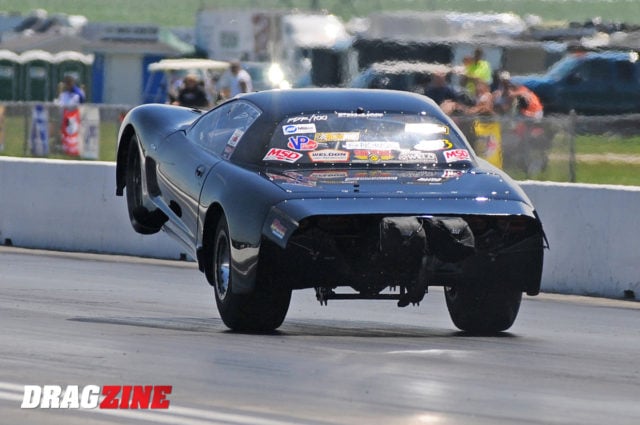
Although power wheelstands are common in the back-half of the track, particularly from turbo cars who have the horsepower to do so, Miller, Switzer and Menscer all shared the same fact: most major wheelstands and blowovers begin around the sixty-foot mark, regardless of when the car finally points due North.
And so, you can understand why the first sixty-feet are so vital to a successful and safe run — if the application of power before the first timing block isn’t matched to the power after it, all bets are off on what happens next.
You’re using the engine’s power to separate the rear suspension; and if you try to go slow to the sixty-foot mark and then pour the power on, you never get the attitude of the chassis high enough. – Jamie Miller
In February of 2015 at Donald Long’s Lights Out 6, Mills endured a high-flying acrobatic act of his own when his “Golden Gorilla” Camaro took flight, catching air under its belly and landing atop the guardrail, resulting in extensive and costly damage. As Miller shares, it was “just the perfect storm of events the led to that; it just so happened that the car started to wheelie. DeWayne pedaled it, which he’s done before, and when he got right back into it, it made the gear change, and it was a recipe for disaster. It loaded the turbos and at that point it snapped the front end up so fast that he couldn’t stop it.”
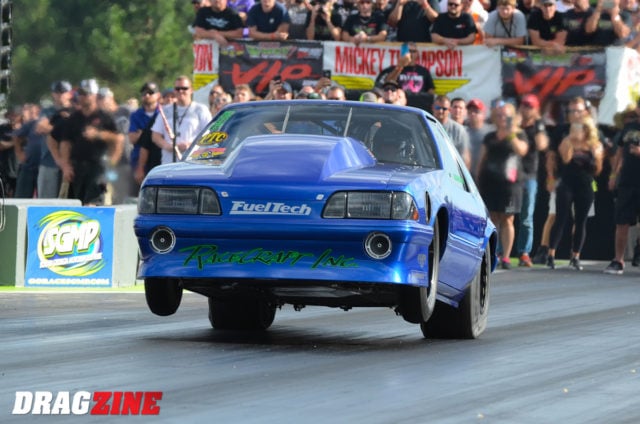
On a stellar run, the quickest of the quick radial racers like to see the left front hiked a few inches off the pavement in the 60-120 foot zone. “If the left front is up then and the right front is still down, we know it’s on a good one,” as racer, tuner, and track prep guru Tyler Crossnoe shared.
Earlier this year, Daniel Pharris obtained arguably the highest altitude to date in a radial car in Tulsa, Oklahoma when his Andrew Alepa-owned Corvette took flight and nearly somersaulted. The team had prepared the car to go 1.03 to sixty-feet and targeted half-track numbers to go 3.78-3.79. However, when the car only went 1.09, it upset the delicate balance of the chassis when the polarization of horsepower occurred and away it went.
Video credit: Urban Hillbilly Videos
To further illustrate just how much power is being applied virtually all at once in a radial car, Miller shares that Mills’, 3,000 pound car has turned in 60-foot to 330-foot splits nearly as quickly as PDRA Pro Extreme racer Jose Gonzalez has in his 2,300 pound, 3.5-second car. The only difference is that Mills is considerably slower to the sixty; so you’re looking less at a slow progression of power and more of an on/off switch here.
Video credit: Hans Pierre Jr. of Free Life Films
Miller says just moving from day to night will play a role in his setup — 100 to 200 rpm on the starting line, about two pounds of boost, and the boost ramp will slow down over half a second from day to night. Forty to 50 pounds may also be moved from the nose to the middle of the car to achieve a specific sixty-foot time.
Technology At Work
A number of forward-thinking manufacturers, including Davis Technologies, have and continue to develop high-tech new tools intended to improve safety in the sport, and in drag radial racing in particular. In addition to more traditional ride height sensors, multi-axis gyroscopic devices are coming into use to sense wheelstands and cut engine power, deploy the parachutes, and a range of other programmable functions. Future devices on the market will also make decisions in scenarios where launch boost doesn’t meet a specified target, where a power wheelstand is increasingly likely.
“You try to put ratios in it that put you further down the track so that you don’t set yourself up for a scenario where it’s making a gear change right in the middle of where power is being introduced. You try to get your boost curve at its peak before the gear change just so that when the motor does make the gear change and loads the turbos, it doesn’t go up.”
For nitrous tuners (and drivers), the balancing act of the many elements in play become even more prudent. Whereas superchargers and turbochargers produce the horsepower to make their steam a little later in a run, a nitrous car has to accomplish it down low; the brute horsepower simply isn’t there to make it up later.
“In a nitrous car, if you want to run with the other cars, you have to ramp the power in as fast as you possibly can, the second it can take it. For that reason, nitrous cars are probably a little more prone to a blowover,” says Brandon Switzer of Switzer Dynamics, who tunes Keith Haney’s Radial versus The World Camaro. “The second the tire is in decent shape, you have to slam it all in as fast as you can to make up as much elapsed time as you can early in the run. That’s our only hope against a turbo car.”
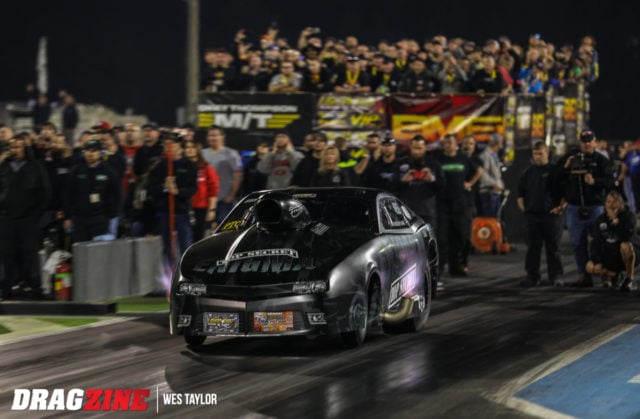
Brandon Switzer handles the engine and nitrous side of the tuning on the Chevrolet Camaro owned and driven by Keith Haney. Brandon Pesz, who has put in some time behind the wheel, as well, tunes the chassis and suspension.
“When and how we apply the power depends so much on the track conditions and where the weight is in the car. It can vary drastically from one track or race to another. I’ve had runs with Keith’s car where we go from the smallest nitrous system to the largest, and other runs where it’s completely opposite, and we go from the biggest to the smallest,” Switzer shares.
In a nitrous car, if you want to run with the other cars, you have to ramp the power in as fast as you possibly can, the second it can take it. For that reason, nitrous cars are probably a little more prone to a blowover. – Brandon Switzer, Switzer Dynamics
In contrast to the boosted application which relies heavily on boost management early on, Switzer indicates he only makes minute adjustments to the introduction points of nitrous from great track to mediocre; instead, he says nitrous tuners focus more on timing advance/retard and torque converter lockup, both of which play a more significant role in whether a car goes into a wheelstand or doesn’t (supercharged racers also manage power with timing, making them similar to nitrous cars in how they approach and avoid wheelstands).
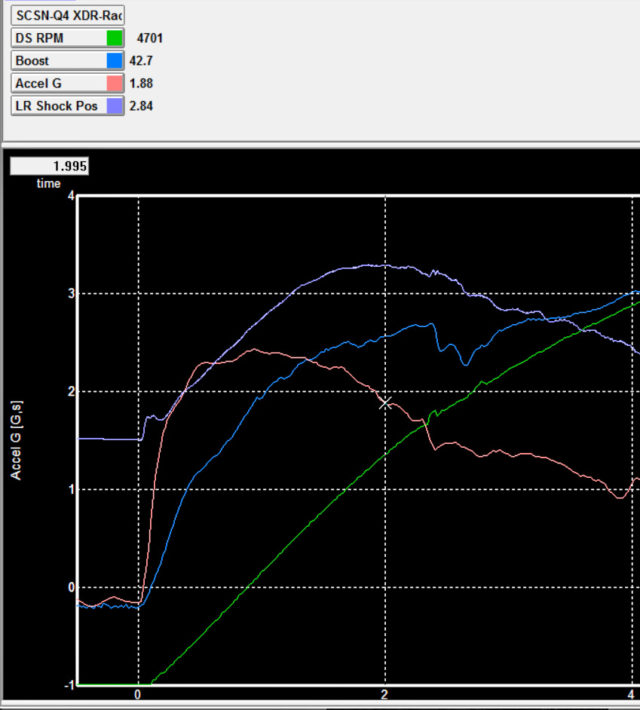
This is a RacePak graph from a run with Dragzine’s Project BlownZ 275 radial Camaro last season. On this pass, the car went 1.12, 2.92, and 4.36 at 171 mph despite needing to pedal at 1.3 seconds (illustrated in the graph). You can see here how abrupt the horsepower is introduced, along with the gradual rise and fall of the rear shocks as the power separates them early in the run before the loss of mechanical force allows the rear of the car to settle back down at speed.
“The blowovers aren’t really controlled by nitrous timers. Just turning the nitrous systems on really fast doesn’t make it blowover, but if there’s an unbelievable amount of traction available through the 100 to 200 foot area, and you don’t have enough weight on the front, and you’re lazy to sixty-feet and you get greedy with the timing and lockup, it will stand straight up.”
While the lock-up point is a closely-guarded secret, Switzer does confirm this happens well before the 330-foot mark.
Of course, as a further contrast, a nitrous car doesn’t have the power to try rotating itself beyond half-track like a turbo car; Switzer sharing there’s “no way in hell it will do it after passing 330-feet,” meaning nitrous racers are generally safely out of the woods so long as they can safely traverse the front half.
“You launch and the nitrous kits are coming on in quick succession, there’s the shift and then another kit, but you’ve got all the timing out of it, and you have a loose converter in the car,” Switzer explains. “So the engine has everything on, but the timing is very retarded; it’s not making a ton of power. So you’re able to get all of that stuff on and get it prepared and ready, and then after the gear change and it gets to about 100 feet is when you start the ballet of bringing the timing in and tightening up the converter. And that’s what either makes it fast or makes it blow over.”
As you can surmise by now, suspension and chassis balance are the key factors in the dynamic of keeping a radial car on the ground. Power management and lockup are highly important, but the chassis is crucial. The dynamics of a radial tire car, of course, require largely an opposing approach to shock design and valving from a slick tire car, as the need to control the rate of extension, not compression, becomes a priority. Other than some earlier ladder bar-style cars that would briefly extend the shock, drag radial racing is the only form of drag racing where this is the case.
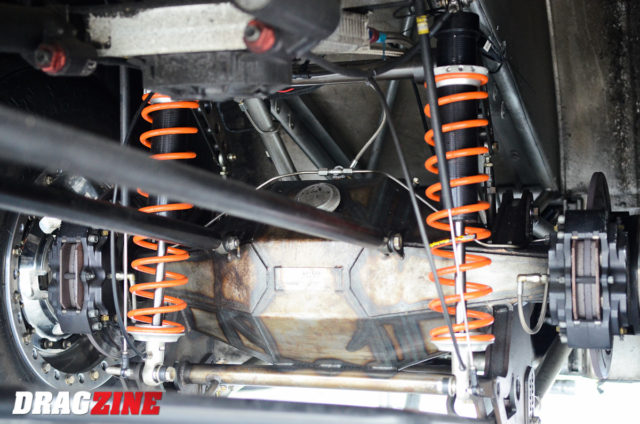
Given the need to rake the chassis to gain the proper attitude for power application, radial cars run longer shock bodies with greater maximum extension versus a comparable slick tire car.
“The idea of setting a car up with a four-link that creates a runaway anti-squat situation to develop thrust angle in the four-link bars, and to continue that separation all the way down the racetrack is very unique to radial racing,” explains shock guru Mark Menscer of Menscer Motorsports. “And it’s really the only application that it’s going to work well on, because with a big slick tire or something, it’s simply going to over-traction the tire and cause a big disaster … it would probably just shake the doors right off of it.”
The idea of setting a car up with a four-link that creates a runaway anti-squat situation to develop thrust angle in the four-link bars, and to continue that separation all the way down the racetrack is very unique to radial racing. Mark Menscer, Menscer Motorsports
“It’s all about metering the rate of separation with the back of the car and the rate of rise in the front of the car and making sure we have a good balance early in the run so that we have traction and a wall to push against with our power management,” Menscer says. “Then, as we get the power in around the 330-foot mark and there’s enough vehicle speed, we start to want to outrun the front — the rate of the rise in the front you want to outrun with the rate of rise in the rear, so that it essentially over-centers and puts the nose back on the ground.”
And that’s where the approach to shocks flip-flops.
Whereas a Pro Modified car is compressing the shock at the launch and gradually releasing, a radial tire car is attempting to instantaneously de-couple the spring and pull the shock body apart. That requires valving to control separation and a unique selection of springs.
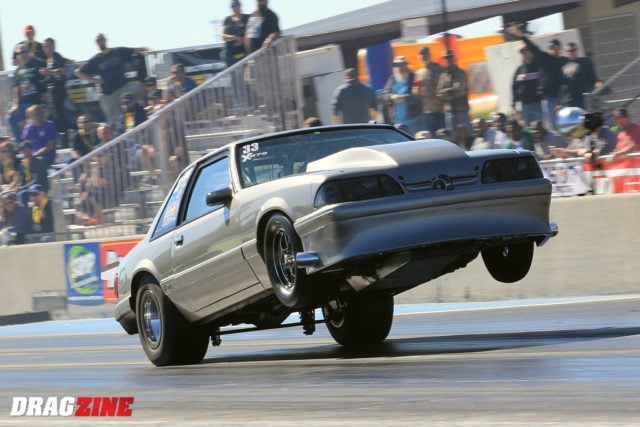
As Menscer shares, stock suspension-style cars, particularly the Fox-body Mustangs with their short upper control arm, are the most violent of radial cars at the initial hit in regards to the immediacy of shock separation.
As Menscer shares, the challenge has been finding a platform that provides enough stored energy and compression in the spring that, when separated by upwards of four-inches, that it doesn’t decouple the spring from its perch going down the racetrack. In essence, the spring is being utilized as means to control extension and to keep the shock body together. Illustrating this unique variable, Menscer says it’s not uncommon to have a spring with a quite soft 80-pound rating on a 3,000-pound radial car, whereas a 2,500-pound Pro Modified car would have a more traditional 125-pound spring.
As you also may have guessed, because there’s a need to put a rake in the chassis, radial racers run a longer shock body than a slick car — Menscer says a typical Radial vs. The World car will have 1.5-inches more total travel than a Pro Mod, and certain custom scenarios (Pro Modified cars that bolt on radials and don’t have adjustable shock mounts on the housing, for example) have even called for a shock with five whole inches longer extension than your average Pro Mod shock.
Brandon Pesz’s wheelstand at Tulsa in the lane opposite of Daniel Pharris
That isn’t to suggest that there isn’t shock compression in a radial car, however, as Menscer says that as RvW cars have gradually increased the size and angles of the rear wings and the height of the wicker bills, they’re finding small rates of compression down-track from the downforce at speed on well-tuned cars. But he says an aggressive position of the four-link bars, even paired with a “soft” spring, can create such a runaway anti-squat scenario that the rear end, under power, can support thousands of pounds of downforce with compressing the shock.
Miller says he sets up Mills’ car where the shock graph will typically resemble a rainbow, sharing that aerodynamics “creates this crazy dynamic, because as the car is trying to separate the shock, you’ve got it lifting the back and the wing angle is pushing it down, so it’s increasing the load into the tire all the way down the track as the two forces fight each other. But this allows you to apply power all the way down the track.”
Taking into account the suspension dynamics of a Radial vs. The World car, you might surmise that lesser-horsepower classes might require a “softer” valving of the extension side of the shock in order to separate it, but Menscer says that isn’t necessarily the case.
On your stock suspension stuff, like a Mustang that has the short upper control arm, they actually separate the shocks harder and faster, earlier in the run than a four-link car. – Mark Menscer
Four-link cars, Menscer explains, will traditionally have bars in the 21- to 22-inch neighborhood, but on a stock suspension car, the lower may be 18-inches and the upper 9-inches — this creates a “motion ratio” that develops leverage quickly, and once it levels out the upper control arm, and the lower control arm has developed its thrust angle, it doesn’t take much horsepower to keep the shock separated.
As he shares, “it’s incredible how violent a stock suspension car can be right at the hit. The instant center starts at, say 29 or 30-inches at the hit, and then as you go down-track it gets longer and longer.”
“These cars can develop 10 to 12-inches of instant center length for every inch of shock separation, so you start with a 30-inch bar, you separate it 3-inches, and you have a 65- to 70-inch bar at half track. It’s a really neat setup, and it’s hand-made for a radial, because it gives you a quick snap right off the button and lots of traction getting to the 330 where you can pour the power on. And it’s also sort of the author of all of those dramatic power wheelstands that you see. That’s because the instant center is getting longer and it’s reaching out forward into the car, and it’s got all this leverage to pick the car up.”
To compensate for the lack of balance in the car, Miller says teams will often place weight on the nose to keep it down, which then causes them to chatter the tire. In reality, he says, they want to leave the weight as-is and “get after it harder” earlier in the run to get the attitude in the chassis correct.
As an interesting side note, Miller points out that when the shock is topped out, two scenarios exist: it’s either got so much bite that it’s got no choice but to pick the front end up if it has enough traction available, or it’s going to spin. There’s no more movement in the rear suspension and it has all the load in the tire, so it can only wheelstand or spin.”
To put it in simple terms, campaigning a radial tire car all comes down to running as quick as feasibly possible with a given combination, without out-accelerating the vehicle. From there, it is — as Switzer so aptly put it — managing a ballet of elements, from boost and timing to weight placement, wing angle, shock settings, and so much more to find a perfect harmony. Understanding what’s really involved in making a successful run at all, much less a good run, gives you all the more appreciation for a perfect 3.7-second lap down the 660 on radials.


